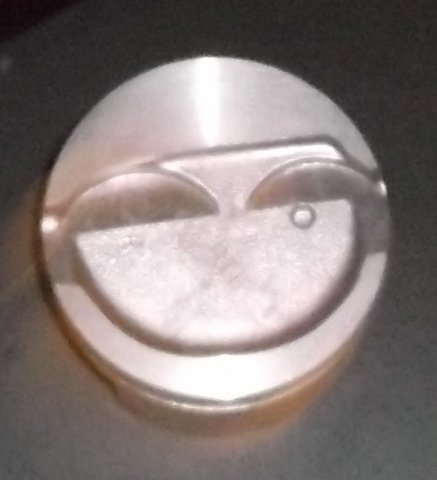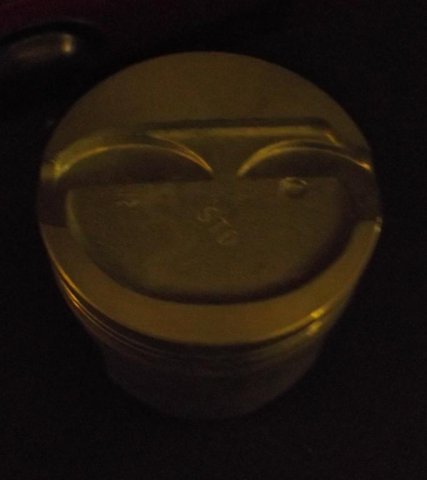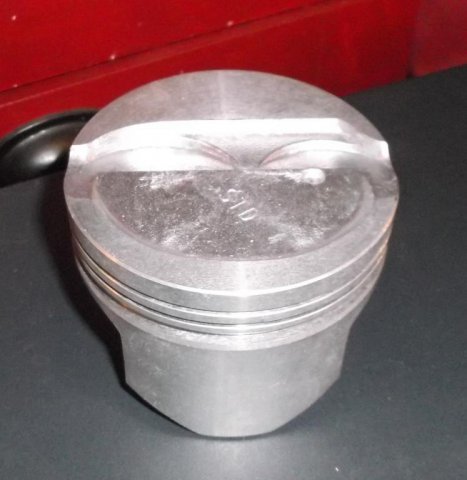
DAW
Members-
Posts
1109 -
Joined
-
Last visited
-
Days Won
2
DAW last won the day on May 3 2006
DAW had the most liked content!
Profile Information
-
Gender
Male
-
Location
Seattle
-
Interests
yes
Recent Profile Visitors
4828 profile views
DAW's Achievements
-
No Longer Available.
-
I have a set new in boxes (Nissan New Old Stock). It would take a significant amount of cash for me to part with them. PayPal only. Shipped insured for $1,000. I have no motivation to sell. I know that I will kick myself in the a** soon after I do. Feel free to PM me.
-
I agree that that is probably a std size Z22S piston with the top machined to both reduce the c.ht. from 35.56 to 33.5, and eliminate the dish. The valve pockets (that don't correspond to anything on the L engine) might amount to 1 cc of volume vs flat top, if that. You can see that there is still a reasonable amount of ring land material above the top ring. This is a very reasonable approach, although you might want to consider a 1 mm oversize (88 mm) piston to work with in order to improve c.r. if you run the P90 head. You might be able to run a Maxima N47 head if you use std dia 87 mm Z22S pistons but you will need to use a big cam because static c.r. will be almost 11:1. However, the closed chamber of that head provides excellent squish which could help limit detonation problems enough for it to work well.
-
I looked up the compression ht for the Z22 pistons and the Z22S is 35.56 mm, while the Z22E is 32.1 mm. This is not ideal because the target of 33.6 (above) is in between the two. Ideally you'd want a squish table on the piston top to line up with the flat of the cylinder head chamber (P90, P79, or MN47 heads) even if there needs to be a dished section of the piston top to correspond to the open portion of the chamber in order to keep the c.r. in range. OEM Z22 pistons are not going to stand up to severe loads. If you consider custom pistons then you might as well try to consider adapting them to a more optimum rod length for the 83 mm stroke than the 133 L24 rod is. I have purchased NOS L13 rods (from Canadian Nissan dealership IIRC) before which at 139.9 mm make for a nice combination with the 83 mm stroke. They use 21mm pins which is convenient but the rod bolts are only 8mm, not 9mm. Basically these conflicts re rod/stroke/piston specs are rooted in the fact that the L28 block is too short to increase stroke easily and have geometry work out well. In the LD28 the 83 mm stroke is matched to 140 mm rods and makes an OK rod/stroke ratio, which could be higher than that for high rpm applications (i.e., use L20B @ 146 mm or Z20E @ 152 mm) but these would only fit into the taller LD28 block; never the L28 series. If you chose a 140 mm rod to use with the LD28 crank in an L28 block it would mean: 208.1 mm (from above post) - 140 mm - 39.5 mm - 2 mm = 26.6 mm. That is a very low compression ht even for a custom piston, especially if that piston is using a larger pin dia too. It spells compromise however you do it while using the L28 block and LD28 crank. No free lunch. I haven't looked at these calculations in years but IIRC there is a Toyota rod of 138 mm length and 22 mm floating pin with the appropriate b.e. width and journal dia. At 138 it would match to a piston c.ht. of 28.6. There is an Eco-Tec piston, std size 86mm, that is basically flat top that has a low c.ht. IIRC it has a floating pin but only 20mm dia. I have no idea if bushing down a rod s.e. for 22mm pin down to match a 22 mm pin is even doable, much less practical. http://www.summitracing.com/parts/wis-k582m86?seid=srese1&gclid=Cj0KEQiA4eqyBRDUh7Omv9vCtsoBEiQAspfs8mhmuZ0xqytty85FvYETUbrul4E0xqrhcP-h4ln8-fEaAssx8P8HAQ The c.ht. is 26.75 mm which is a bit too short for a 138 mm rod (would need 28.6 to be zero deck) but it is very close to the 26.5 mm needed for use with the L13 rod (139.9 mm). The rub is that the L13 rod bolts are only 8mm, otherwise the s.e. for pressed fit 21 mm pin could probably be bushed for the 20mm EcoTec piston pin. L13 parts won't be found in US market but maybe JDM, AU, NZ, etc sources. It's a quagmire but in general it seems that compression hts of pistons in newer engines are lower than in older engine designs so it is worth browsing specs every now and then. see: http://www.wiseco.com/Catalogs/SportCompact/CompleteCatalog.pdf
-
Hi, Break it down to numbers/specs and don't get too fixated on the source of your parts. By that I mean that there might be a Hyundai or Chrysler piston that better suits your specific need. That's not to say that Nissan parts might eventually end up being your source, especially re 21mm pin dia choices. First set your basic parameters: Stroke (and which rod lengths go with that stroke). 83mm is not a big stroke but in the L block (as opposed to LxxB and LDxx blocks which are 19.7mm taller deck) it is cramped in there so you are going to end up needing a piston with a very short pin ht (comp. ht). It will ultimately become about finding an accessible piston donor source with the needed pin ht, and then arriving at the available piston dia's (std, oversizes, etc) and not the other way around. For 83mm stroke you do not use a 130.45mm rod length even if you get new forged ones for free. An appropriate rod length (re rod/stroke ratio) for an 86mm stroke L series is as the L20B is at 145.9mm. You need at least the 133mm length of L24 and L16 (use mid-'72 thru '73 to get strongest rods/bolts; earlier were inferior/smaller). There are some 135-138 'ish rods from Toyota and I'm thinking Saab, and maybe Nissan FJ20? that could work re their cap width and journal diameters. Of these some are nice forged units and some are floating pin, but choosing the Nissan L-series is the easiest way to go. Start with a stock baseline for your calculations, i.e., L28 has 79mm stroke and 130.5 rods and 38.1 c.ht pistons. Every time you do any calculations with stroke length you need to cut those numbers in half for obvious reasons. We are working with distances above horizontal centerline only. Consider the L28 block ht to be fixed at the factory and you don't even need to know what it is, because add together 130.5 mm + 38.1 mm + [79/2= 39.5 mm] = 208.1 mm. Then if you substitute the 83 mm crankshaft you are adding (83-79/2 mm = 2 mm) above crank center line that you need to compensate for. Take that off of the c.ht. (38.1 - 2 = 36.1). The 130.5 rods are way too short now for the increased stroke and you'll need 133 mm minimum, so for 133 take 2.5 mm more off of the c. ht.. i.e. (36.1 - 2.5 = 33.6 mm). 33.6 mm is not an unusually low pin ht and piston choices/OEM sources will be pretty easy to find. You can look it up but it is more likely that you'll want the Z22E piston (200sx) rather than the truck Z22S piston (720), because the car uses a shorter pin ht. {not surprising: lower rod/stroke needed for a lower rpm range truck vs a car}. I'm guessing re actual pin ht. difference. You do the arithmetic to check it out. Good luck.
-
I used a set of 280ZX headers for L28 on my '82 Maxima 910 LD28 and they fit fine. That block is 3/4" taller than the L28 block but the headers may still fit. The 810 Maxima shares the same basic platform as the 280ZX. I think the earlier 810 is like the '79 280ZX in that they have the recirc ball type steering rather than the rack & pinion of '81 on. The crossmembers are different. I used 280ZXT sway bars on my Maxima, they were bolt-on. Is your 810 2 dr IRS? The motor mounts on the Maxima 810 relocate the block about 1.5" forward which helps the front-sump oil pan clear the crossmember. One thing nice about the LD28 front sump oil pan, besides the large capacity, is that it has an oil return port used for the diesel engine vacuum pump. It has potential for turbo oil drain plumbing and is on the same side (driver's) of engine. LD28 also incorporates an oil-water oil cooler...or you could use an OEM 280ZXT (with A/T) oil/air cooler and oil pump.
-
Are you using the OEM L28ET timer-fan for the intake/injectors? Designed to combat heat-soak. Runs for timed 17 min (or so) when car is shut down and coolant temp is above some threshold. Also, crack the hood open when you park it and consider some of those louvered inspection panels to let the heat out.
-
I'm not really clear on your idea here but if you are going to use six individual carbs, then you wouldn't want a fabricated plenum manifold. That defeats your purpose. You would be better off using a readily available triple side-draft (Webers) manifold and adapting your six Mikuni carbs to it. There are some rubber mount adapters that match the individual motorcycle carbs to Weber spec inlet bolt pattern (with minimal modification) that could make it possible. Ebay source for the adapters. You would need to research this, I saw it somewhere recently. Linkage would be a nightmare though. If you are going to design and fabricate an intake manifold it may make more sense to use an OEM L28E efi manifold mounting base, cut the runners off just upstream of the injectors and go from there. You could design your manifold to interface with these stubs using neoprene boots and clamps. Maybe something plastic/3-D printed, IDK. I've never seen much attention paid re datsun L6 induction to equal length runners pair by firing intervals. i.e., 3-4; 2-5; 1-6, to extract low end torque performance through resonance tuning. Look at BMW inline six efi runners as an example. You could run three individual throttle plates for each pair of runners, or one throttle plate and a plenum. If your goal is to optimize throttle response and WOT performance both, then just go with available triple side drafts in 40mm or 45mm sized throttle plates(Weber, Mikuni, Solex, Delleroto; i.e., the work-a-likes that all share the same mounting base/bolt spreads). 40mm's are far more common and available used. Or ITB's if you can afford them. You could do something creative in tuning paired airflow runners upstream of the carbs and maybe incorporate a two-stage induction setup that you design. Look at other high-tech inline six two stage OEM manifolds: BMW, Mercedes, etc. for ideas.
- 48 replies
-
Those JE pistons do look similar. See how three are the reverse configuration re exhaust/intake reliefs? The problem with using pistons from a V6 in an inline six engine is that three are going to be the wrong piston pin offset for the rotation direction. That's why I was going to cut the exhaust valve reliefs to be symmetrical to the intake valve reliefs on all six pistons. It is a compromise but not giving up much for the sake of attaining good squish and keeping c.r. useable on high displacement engines. I hadn't considered valve-piston clearance as even an issue in what I'm referring to because it looks like there is plenty there. (In that sense I hijacked the thread) Again, this is more of an issue on L4 engines because there are no raised roof/closed chamber heads available for L4 as there are for L6. Anecdote: I bought a rather hacked up road race 510 years ago, 1600 cc, and I had the head off for some reason and noticed that there were nicks in the piston tops on #2 and #3 cylinders from intake valve contact (not enough to bend the valves). That was because PO had the #2 and #3 pistons assembled into the wrong holes. They were nice forged pop-up pistons. I reversed them in their holes, sorted some other things out, and raced SCCA Solo I and II with the car. PO was a dyslexic engine builder I guess.
-
they aren't custom pistons, they just happen to line-up flat-to-flat tables. Pins are 21mm; c.ht is 34 mm. After fly-cutting, the intake eyebrow would match symmetrically to what you machine in next to it...the identical eyebrow. It is an experiment but seems sound.
-
Here is what I am referring to: ...the table on the piston top is juxtaposed to the table on the cyl head = squish/quench, etc = high c.r. resistant to knock.
-
There would be one solution if it were me. Although the P79 exhaust ports don't match the L28ET manifold ports as they do on the P90 head, with the combination you have there (which by the way is terrible. the c.r. is only suitable for turbo or super charging). I'd port match the best I could and run a medium boost conservative turbo with an intercooler. Bear in mind that the 280ZXT did not have an intercooler. But you have to run the turbo (brown-top) injectors and ECCS for the turbo; or else you need mega squirt-type support. Or, you could adapt a fuel ignition mgmt. from a late model I6 type engine, like BMW por ejamplo.
-
It sounds like the auxilliary air valve was stuck but now it is working.
-
Pro/Con of combining valve cover and engine breathers
DAW replied to zredbaron's topic in Nissan L6 Forum
I've run triple sidedrafts with a pcv system with no problem. Although with a big cam you might need a vacuum reservoir with a check valve. Are you able to use factory power brakes? Turbo engines need to preserve negative pressure functions even under boost so you should be to at atmospheric pressure. But if traditional pcv system doesn't work then source your vacuum from the collector (and dump it into the high temp exhaust gasses to be rid of it, although burning as a combustion additive regulated through pcv valve is cleaner). Regardless, the valve cover port is for filtered fresh air coming in. I like to run an intake hose (after a 90 degree bend) away from that port at an incline and place its breather filter along the firewall (vertically oriented). It's less messy and preserves some oil vapor. But it could instead be plumbed from the filtered side of your airbox. It should not be hooked directly to the crankcase vapor outlet. That would unbalance vapor pressure and flow which would not serve any purpose and would potentially cause power-robbing increased crankcase pressure instead. The crankcase vent outlet is off of the block and is not just a passive vent, it has an evacuating function to respond to increased crankcase pressures due to high engine speeds. The pcv valve regulates blow-by pressure build up while conserving and recovering oil vapor instead of wasting it, keeping gaskets from spewing oil, and making sure that the air that enters the crankcase is clean, filtered air. And not some backwash air sucked in from under the chassis somewhere. Old cars used to have a wire mesh filter on the intake side of the crankcase and a road-draft tube to evacuate. That tube exited down by the trans and was cut at an angle on the end such that increased vehicle speed increased the negative pressure on the system (and let oil vapors spew into the vehicle slipstream). There are no good reasons to do away with emission controls as basic as pcv and evaporative emissions. I'm including collector suction devices too as pcv regulators (if you have a low or wildly fluctuating vacuum signal). -
I guess I'm not sure by what you mean as chamber matching. I think that is what I'm refering to re matching a flat portion of the piston top up with a flat portion of the cylinder head chamber to maximize squish. The dish portion of the piston top is needed to keep compression ratio down. This would apply in L6's to larger displacement than unstroked L28 where you want to use a closed chamber head but can't use full flat top (no partial dish), or the c.r. would be too high.


